Knowledge Structure and Frontier Evolution of Research on Chromitite: A Scientometric Review
Abstract
1. Introduction
2. Data and Analytical Methods
2.1. Data Sources
2.2. Analytical Methods
3. Results
3.1. Annual Publishing Trends
3.2. Author Co-Occurrence Network Analysis
3.3. Institutions and Countries/Regions Co-Occurrence Network Analysis
3.4. References Analysis
3.5. Keywords
4. The Research Frontier for Chromitite
5. Conclusions
Supplementary Materials
Author Contributions
Funding
Acknowledgments
Conflicts of Interest
References
- Boyd, D.; Crawford, K. CRITICAL QUESTIONS FOR BIG DATA: Provocations for a cultural, technological, and scholarly phenomenon. Inf. Commun. Soc. 2012, 15, 662–679. [Google Scholar] [CrossRef]
- Chen, C. Searching for intellectual turning points: Progressive knowledge domain visualization. Proc. Natl. Acad. Sci. USA 2004, 101 (Suppl. S1), 5303–5310. [Google Scholar] [CrossRef]
- Sivarajah, U.; Kamal, M.M.; Irani, Z.; Weerakkody, V. Critical analysis of Big Data challenges and analytical methods. J. Bus. Res. 2017, 70, 263–286. [Google Scholar] [CrossRef]
- Wang, C.; Ma, X.; Chen, J. Ontology-driven data integration and visualization for exploring regional geologic time and paleontological information. Comput. Geosci. 2018, 115, 12–19. [Google Scholar] [CrossRef]
- Wang, C.; Ma, X.; Chen, J.; Chen, J. Information extraction and knowledge graph construction from geoscience literature. Comput. Geosci. 2018, 112, 112–120. [Google Scholar] [CrossRef]
- Chen, C.; Hu, Z.; Liu, S.; Tseng, H. Emerging trends in regenerative medicine: A scientometric analysis in CiteSpace. Expert Opin. Biol. Ther. 2012, 12, 593–608. [Google Scholar] [CrossRef] [PubMed]
- Jahangirian, M.; Eldabi, T.; Garg, L.; Jun, G.T.; Naseer, A.; Patel, B.; Stergioulas, L.; Young, T. A rapid review method for extremely large corpora of literature: Applications to the domains of modelling, simulation, and management. Int. J. Inf. Manag. 2011, 31, 234–243. [Google Scholar] [CrossRef]
- Van Eck, N.J.; Waltman, L. Software survey: VOSviewer, a computer program for bibliometric mapping. Scientometrics 2010, 84, 523–538. [Google Scholar] [CrossRef]
- Persson, O.D.; Danell, R.; Wiborg, S.J. How to use Bibexcel for various types of bibliometric analysis. In Celebrating Scholarly Communication Studies: A Festschrift for Persson at His 60th Birthday; Åström, F.R., Larsen, D.B., Schneider, J., Eds.; International Society for Scientometrics and Informetrics: Leuven, Belgium, 2009; pp. 9–24. [Google Scholar]
- Dorogovtsev, S.N.; Mendes, J.F.F.; Samukhin, A.N. Structure of Growing Networks with Preferential Linking. Phys. Rev. Lett. 2000, 85, 4633–4636. [Google Scholar] [CrossRef]
- Albert, R.; Barabási, A.-L. Statistical mechanics of complex networks. Rev. Mod. Phys. 2002, 74, 47–97. [Google Scholar] [CrossRef]
- Zuo, Z.; Cheng, J.; Guo, H.; Li, Y. Knowledge mapping of research on strategic mineral resource security: A visual analysis using CiteSpace. Resour. Policy 2021, 74, 102372. [Google Scholar] [CrossRef]
- Yao, L.; Hui, L.; Yang, Z.; Chen, X.; Xiao, A. Freshwater microplastics pollution: Detecting and visualizing emerging trends based on Citespace II. Chemosphere 2019, 245, 125627. [Google Scholar] [CrossRef] [PubMed]
- Liao, H.; Tang, M.; Luo, L.; Li, C.; Chiclana, F.; Zeng, X.-J. A Bibliometric Analysis and Visualization of Medical Big Data Research. Sustainability 2018, 10, 166. [Google Scholar] [CrossRef]
- Peng, H.; Guo, J.; Lv, L.; Huang, H.; Li, B. Recovery of chromium by calcium-roasting, sodium-roasting, acidic leaching, alkaline leaching and sub-molten technology: A review. Environ. Chem. Lett. 2020, 19, 1383–1393. [Google Scholar] [CrossRef]
- Murthy, Y.R.; Tripathy, S.K.; Kumar, C.R. Chrome ore beneficiation challenges & opportunities—A review. Miner. Eng. 2011, 24, 375–380. [Google Scholar] [CrossRef]
- Sanchez-Segado, S.; Makanyire, T.; Escudero-Castejon, L.; Hara, Y.; Jha, A. Reclamation of reactive metal oxides from complex minerals using alkali roasting and leaching—an improved approach to process engineering. Green Chem. 2015, 17, 2059–2080. [Google Scholar] [CrossRef]
- Thayer, T.P. Some critical differences between alpine-type and stratiform peridotite-gabbro complexes, International Geol. In Proceedings of the Congress, Rept. of the 21st Session, Copenhagen, Denmark, 10–25 August 1960; pp. 247–259. [Google Scholar]
- Schulte, R.F.; Taylor, R.D.; Piatak, N.M.; Seal, R.R. Stratiform Chromite Deposit Model, Chapter E in Mineral Deposit Models for Resource Assessment; Scientific Investigations Report 2010–5070–E.; U.S. Geological Survey: Reston, VA, USA, 2012; p. 131.
- Smith, W.; Maier, W.; Barnes, S.; Moorhead, G.; Reid, D.; Karykowski, B. Element mapping the Merensky Reef of the Bushveld Complex. Geosci. Front. 2020, 12, 101101. [Google Scholar] [CrossRef]
- Marques, J.C.; Filho, C.F.F. The Chromite Deposit of the Ipueira-Medrado Sill, Sao Francisco Craton, Bahia State, Brazil. Econ. Geol. 2003, 98, 87–108. [Google Scholar] [CrossRef]
- O’Driscoll, B.; Donaldson, C.H.; Daly, J.S.; Emeleus, C.H. The roles of melt infiltration and cumulate assimilation in the formation of anorthosite and a Cr-spinel seam in the Rum Eastern Layered Intrusion, NW Scotland. Lithos 2009, 111, 6–20. [Google Scholar] [CrossRef]
- Uysal, I.; Akmaz, R.M.; Kapsiotis, A.; Demir, Y.; Saka, S.; Avcı, E.; Müller, D. Genesis and geodynamic significance of chromitites from the Orhaneli and Harmancık ophiolites (Bursa, NW Turkey) as evidenced by mineralogical and compositional data. Ore Geol. Rev. 2015, 65, 26–41. [Google Scholar] [CrossRef]
- Wu, W.; Yang, J.; Dilek, Y.; Milushi, I.; Lian, D. Multiple episodes of melting, depletion, and enrichment of the Tethyan mantle: Petrogenesis of the peridotites and chromitites in the Jurassic Skenderbeu massif, Mirdita ophiolite, Albania. Lithosphere 2017, 10, 54–78. [Google Scholar] [CrossRef]
- Lian, D.; Yang, J.; Wiedenbeck, M.; Dilek, Y.; Rocholl, A.; Wu, W. Carbon and nitrogen isotope, and mineral inclusion studies on the diamonds from the Pozanti–Karsanti chromitite, Turkey. Contrib. Miner. Pet. 2018, 173, 72. [Google Scholar] [CrossRef]
- Lian, D.; Yang, J.; Dilek, Y.; Wu, W.; Zhang, Z.; Xiong, F.; Liu, F.; Zhou, W. Deep mantle origin and ultra-reducing conditions in podiform chromitite: Diamond, moissanite, and other unusual minerals in podiform chromitites from the Pozanti-Karsanti ophiolite, southern Turkey. Am. Miner. 2017, 102, 1101–1113. [Google Scholar] [CrossRef]
- Cai, P.; Chen, X.; Majka, J.; Klonowska, I.; Jeanneret, P.; Xu, R.; Zheng, Y. Two stages of crust-mantle interaction during oceanic subduction to continental collision: Insights from mafic-ultramafic complexes in the North Qaidam orogen. Gondwana Res. 2020, 89, 247–264. [Google Scholar] [CrossRef]
- Su, B.; Zhou, M.; Jing, J.; Robinson, P.T.; Chen, C.; Xiao, Y.; Liu, X.; Shi, R.; Lenaz, D.; Hu, Y. Distinctive melt activity and chromite mineralization in Luobusa and Purang ophiolites, southern Tibet: Constraints from trace element compositions of chromite and olivine. Sci. Bull. 2019, 64, 108–121. [Google Scholar] [CrossRef]
- Su, B.-X.; Robinson, P.T.; Chen, C.; Xiao, Y.; Melcher, F.; Bai, Y.; Gu, X.-Y.; Uysal, I.; Lenaz, D. The occurrence, origin, and fate of water in chromitites in ophiolites. Am. Miner. 2020, 105, 894–903. [Google Scholar] [CrossRef]
- Su, B.; Liu, X.; Chen, C.; Robinson, P.T.; Xiao, Y.; Zhou, M.; Bai, Y.; Uysal, I.; Zhang, P. A new model for chromitite formation in ophiolites: Fluid immiscibility. Sci. China Earth Sci. 2020, 64, 220–230. [Google Scholar] [CrossRef]
- Rui, H.-C.; Yang, J.-S.; Castro, A.I.L.; Zheng, J.-P.; Lian, D.-Y.; Wu, W.-W.; Mariño, Y.V. Ti-poor high-Al chromitites of the Moa-Baracoa ophiolitic massif (eastern Cuba) formed in a nascent forearc mantle. Ore Geol. Rev. 2022, 144. [Google Scholar] [CrossRef]
- Arai, S.; Akizawa, N. Precipitation and dissolution of chromite by hydrothermal solutions in the Oman ophiolite: New behavior of Cr and chromite. Am. Miner. 2014, 99, 28–34. [Google Scholar] [CrossRef]
- Puchtel, I.S.; Humayun, M.; Campbell, A.J.; Sproule, R.A.; Lesher, C. Platinum group element geochemistry of komatiites from the Alexo and Pyke Hill areas, Ontario, Canada. Geochim. Cosmochim. Acta 2004, 68, 1361–1383. [Google Scholar] [CrossRef]
- Economou-Eliopoulos, M. Platinum-group element distribution in chromite ores from ophiolite complexes: Implications for their exploration. Ore Geol. Rev. 1996, 11, 363–381. [Google Scholar] [CrossRef]
- Akmaz, R.M.; Uysal, I.; Saka, S. Compositional variations of chromite and solid inclusions in ophiolitic chromitites from the southeastern Turkey: Implications for chromitite genesis. Ore Geol. Rev. 2014, 58, 208–224. [Google Scholar] [CrossRef]
- Uysal, I.; Tarkian, M.; Sadiklar, M.B.; Zaccarini, F.; Meisel, T.; Garuti, G.; Heidrich, S. Petrology of Al- and Cr-rich ophiolitic chromitites from the Muğla, SW Turkey: Implications from composition of chromite, solid inclusions of platinum-group mineral, silicate, and base-metal mineral, and Os-isotope geochemistry. Contrib. Miner. Pet. 2009, 158, 659–674. [Google Scholar] [CrossRef]
- Uysal, I.; Ersoy, E.Y.; Karslı, O.; Dilek, Y.; Sadıklar, M.B.; Ottley, C.J.; Tiepolo, M.; Meisel, T. Coexistence of abyssal and ultra-depleted SSZ type mantle peridotites in a Neo-Tethyan Ophiolite in SW Turkey: Constraints from mineral composition, whole-rock geochemistry (major–trace–REE–PGE), and Re–Os isotope systematics. Lithos 2012, 132–133, 50–69. [Google Scholar] [CrossRef]
- Ghosh, B.; Ray, J.; Morishita, T. Grain-scale plastic deformation of chromite from podiform chromitite of the Naga-Manipur ophiolite belt, India: Implication to mantle dynamics. Ore Geol. Rev. 2014, 56, 199–208. [Google Scholar] [CrossRef]
- Zhang, P.-F.; Zhou, M.-F.; Su, B.-X.; Uysal, I.; Robinson, P.T.; Avci, E.; He, Y.-S. Iron isotopic fractionation and origin of chromitites in the paleo-Moho transition zone of the Kop ophiolite, NE Turkey. Lithos 2017, 268–271, 65–75. [Google Scholar] [CrossRef]
- Barnes, S.J.; Roeder, P.L. The Range of Spinel Compositions in Terrestrial Mafic and Ultramafic Rocks. J. Pet. 2001, 42, 2279–2302. [Google Scholar] [CrossRef]
- Yang, J.; Bai, W.; Fang, Q.; Yan, B.; Shi, N.; Ma, Z.; Dai, M.; Xiong, M. Silicon-rutile—An ultra-high pressure (UHP) mineral from an ophiolite. Prog. Nat. Sci. 2003, 13, 528–531. [Google Scholar] [CrossRef]
- Yang, J.-S.; Dobrzhinetskaya, L.; Bai, W.-J.; Fang, Q.-S.; Robinson, P.T.; Zhang, J.; Green, H.W. Diamond-and coesite-bearing chromitites from the Luobusa ophiolite, Tibet. Geology 2007, 35, 875. [Google Scholar] [CrossRef]
- Yang, J.-S.; Robinson, P.T.; Dilek, Y. Diamonds in Ophiolites. Elements 2014, 10, 127–130. [Google Scholar] [CrossRef]
- Zhou, M.-F.; Robinson, P.T.; Su, B.-X.; Gao, J.-F.; Li, J.-W.; Yang, J.-S.; Malpas, J. Compositions of chromite, associated minerals, and parental magmas of podiform chromite deposits: The role of slab contamination of asthenospheric melts in suprasubduction zone environments. Gondwana Res. 2014, 26, 262–283. [Google Scholar] [CrossRef]
- Robinson, P.T.; Trumbull, R.B.; Schmitt, A.; Yang, J.-S.; Li, J.-W.; Zhou, M.-F.; Erzinger, J.; Dare, S.; Xiong, F. The origin and significance of crustal minerals in ophiolitic chromitites and peridotites. Gondwana Res. 2015, 27, 486–506. [Google Scholar] [CrossRef]
- Yang, J.; Meng, F.; Xu, X.; Robinson, P.T.; Dilek, Y.; Makeyev, A.B.; Wirth, R.; Wiedenbeck, M.; Cliff, J. Diamonds, native elements and metal alloys from chromitites of the Ray-Iz ophiolite of the Polar Urals. Gondwana Res. 2015, 27, 459–485. [Google Scholar] [CrossRef]
- Rollinson, H.; Adetunji, J. The geochemistry and oxidation state of podiform chromitites from the mantle section of the Oman ophiolite: A review. Gondwana Res. 2015, 27, 543–554. [Google Scholar] [CrossRef]
- Xiong, F.; Yang, J.; Robinson, P.T.; Xu, X.; Liu, Z.; Li, Y.; Li, J.; Chen, S. Origin of podiform chromitite, a new model based on the Luobusa ophiolite, Tibet. Gondwana Res. 2015, 27, 525–542. [Google Scholar] [CrossRef]
- Xu, X.; Yang, J.; Robinson, P.T.; Xiong, F.; Ba, D.; Guo, G. Origin of ultrahigh pressure and highly reduced minerals in podiform chromitites and associated mantle peridotites of the Luobusa ophiolite, Tibet. Gondwana Res. 2015, 27, 686–700. [Google Scholar] [CrossRef]
- González-Jiménez, J.M.; Locmelis, M.; Belousova, E.; Griffin, W.L.; Gervilla, F.; Kerestedjian, T.N.; O’Reilly, S.Y.; Pearson, N.J.; Sergeeva, I. Genesis and tectonic implications of podiform chromitites in the metamorphosed ultramafic massif of Dobromirtsi (Bulgaria). Gondwana Res. 2013, 27, 555–574. [Google Scholar] [CrossRef]
- Litasov, K.D.; Kagi, H.; Bekker, T.; Hirata, T.; Makino, Y. Cuboctahedral type Ib diamonds in ophiolitic chromitites and peridotites: The evidence for anthropogenic contamination. High Press. Res. 2019, 39, 480–488. [Google Scholar] [CrossRef]
- Litasov, K.; Kagi, H.; Voropaev, S.; Hirata, T.; Ohfuji, H.; Ishibashi, H.; Makino, Y.; Bekker, T.; Sevastyanov, V.; Afanasiev, V.; et al. Comparison of enigmatic diamonds from the Tolbachik arc volcano (Kamchatka) and Tibetan ophiolites: Assessing the role of contamination by synthetic materials. Gondwana Res. 2019, 75, 16–27. [Google Scholar] [CrossRef]
- González-Jiménez, J.M.; Griffin, W.L.; Proenza, J.A.; Gervilla, F.; O’Reilly, S.Y.; Akbulut, M.; Pearson, N.J.; Arai, S. Chromitites in ophiolites: How, where, when, why? Part II. The crystallization of chromitites. Lithos 2014, 189, 140–158. [Google Scholar] [CrossRef]
- Arai, S.; Miura, M. Formation and modification of chromitites in the mantle. Lithos 2016, 264, 277–295. [Google Scholar] [CrossRef]
- González-Jiménez, J.; Proenza, J.; Gervilla, F.; Melgarejo, J.; Blanco-Moreno, J.; Ruiz-Sánchez, R.; Griffin, W. High-Cr and high-Al chromitites from the Sagua de Tánamo district, Mayarí-Cristal ophiolitic massif (eastern Cuba): Constraints on their origin from mineralogy and geochemistry of chromian spinel and platinum-group elements. Lithos 2011, 125, 101–121. [Google Scholar] [CrossRef]
- González-Jiménez, J.M.; Griffin, W.L.; Gervilla, F.; Proenza, J.A.; O’Reilly, S.Y.; Pearson, N.J. Chromitites in ophiolites: How, where, when, why? Part I. A review and new ideas on the origin and significance of platinum-group minerals. Lithos 2013, 189, 127–139. [Google Scholar] [CrossRef]
- Maier, W.D.; Barnes, S.-J.; Groves, D.I. The Bushveld Complex, South Africa: Formation of platinum–palladium, chrome- and vanadium-rich layers via hydrodynamic sorting of a mobilized cumulate slurry in a large, relatively slowly cooling, subsiding magma chamber. Miner. Deposita 2013, 48, 1–56. [Google Scholar] [CrossRef]
- Naldrett, A.J.; Wilson, A.; Kinnaird, J.; Yudovskaya, M.; Chunnett, G. The origin of chromitites and related PGE mineralization in the Bushveld Complex: New mineralogical and petrological constraints. Miner. Deposita 2011, 47, 209–232. [Google Scholar] [CrossRef]
- Griffin, W.L.; Afonso, J.; Belousova, E.; Gain, S.; Gong, X.-H.; Jiménez, J.M.G.; Howell, D.; Huang, J.; McGowan, N.; Pearson, N.J.; et al. Mantle Recycling: Transition Zone Metamorphism of Tibetan Ophiolitic Peridotites and its Tectonic Implications. J. Pet. 2016, 57, 655–684. [Google Scholar] [CrossRef]
- McGowan, N.M.; Griffin, W.L.; González-Jiménez, J.M.; Belousova, E.; Afonso, J.; Shi, R.; McCammon, C.A.; Pearson, N.J.; O’Reilly, S.Y. Tibetan chromitites: Excavating the slab graveyard. Geology 2015, 43, 179–182. [Google Scholar] [CrossRef]
- Arai, S. Conversion of low-pressure chromitites to ultrahigh-pressure chromitites by deep recycling: A good inference. Earth Planet. Sci. Lett. 2013, 379, 81–87. [Google Scholar] [CrossRef]
- O’Driscoll, B.; González-Jiménez, J.M. Petrogenesis of the Platinum-Group Minerals. Rev. Mineral. Geochem. 2016, 81, 489–578. [Google Scholar] [CrossRef]
- Junge, M.; Oberthür, T.; Melcher, F. Cryptic Variation Of Chromite Chemistry, Platinum Group Element And Platinum Group Mineral Distribution In The Ug-2 Chromitite: An Example From The Karee Mine, Western Bushveld Complex, South Africa. Econ. Geol. 2014, 109, 795–810. [Google Scholar] [CrossRef]
- Miura, M.; Arai, S.; Ahmed, A.H.; Mizukami, T.; Okuno, M.; Yamamoto, S. Podiform chromitite classification revisited: A comparison of discordant and concordant chromitite pods from Wadi Hilti, northern Oman ophiolite. J. Southeast Asian Earth Sci. 2012, 59, 52–61. [Google Scholar] [CrossRef]
- Zaccarini, F.; Garuti, G.; Proenza, J.A.; Campos, L.; Thalhammer, O.A.R.; Aiglsperger, T.; Lewis, J.F. Chromite and platinum group elements mineralization in the santa elena ultramafic nappe (costa rica): Geodynamic implications. Geol. Acta 2011, 9, 407–423. [Google Scholar] [CrossRef]
- Zeng, Z.; Hengsadeekul, T. Environmental issues and social responsibility: A scientomeric analysis using citespace. Entrep. Sustain. Issues 2020, 8, 1419–1436. [Google Scholar] [CrossRef]
- Hou, J.; Yang, X.; Chen, C. Emerging trends and new developments in information science: A document co-citation analysis (2009–2016). Scientometrics 2018, 115, 869–892. [Google Scholar] [CrossRef]
- Zhou, M.-F.; Robinson, P.T.; Malpas, J.; Li, Z. Podiform Chromitites in the Luobusa Ophiolite (Southern Tibet): Implications for Melt-Rock Interaction and Chromite Segregation in the Upper Mantle. J. Pet. 1996, 37, 3–21. [Google Scholar] [CrossRef]
- Melcher, F.; Grum, W.; Simon, G.; Thalhammer, T.V.; Stumpfl, E.F. Petrogenesis of the Ophiolitic Giant Chromite Deposits of Kempirsai, Kazakhstan: A Study of Solid and Fluid Inclusions in Chromite. J. Pet. 1997, 38, 1419–1458. [Google Scholar] [CrossRef]
- Barnes, S.-J.; Maier, W.D. Platinum-group Elements and Microstructures of Normal Merensky Reef from Impala Platinum Mines, Bushveld Complex. J. Pet. 2002, 43, 103–128. [Google Scholar] [CrossRef]
- Zaccarini, F.; Proenza, J.A.; Gutierrez, F.O.; Garuti, G. Platinum group minerals in ophiolitic chromitites from Tehuitzingo (Acatlán complex, southern Mexico): Implications for post-magmatic modification. Miner. Pet. 2005, 84, 147–168. [Google Scholar] [CrossRef]
- Yamamoto, S.; Komiya, T.; Hirose, K.; Maruyama, S. Coesite and clinopyroxene exsolution lamellae in chromites: In-situ ultrahigh-pressure evidence from podiform chromitites in the Luobusa ophiolite, southern Tibet. Lithos 2009, 109, 314–322. [Google Scholar] [CrossRef]
- Mukherjee, R.; Mondal, S.K.; Rosing, M.T.; Frei, R. Compositional variations in the Mesoarchean chromites of the Nuggihalli schist belt, Western Dharwar Craton (India): Potential parental melts and implications for tectonic setting. Contrib. Miner. Pet. 2010, 160, 865–885. [Google Scholar] [CrossRef]
- Dilek, Y.; Furnes, H. Ophiolite genesis and global tectonics: Geochemical and tectonic fingerprinting of ancient oceanic lithosphere. GSA Bull. 2011, 123, 387–411. [Google Scholar] [CrossRef]
- Arai, S.; Okamura, H.; Kadoshima, K.; Tanaka, C.; Suzuki, K.; Ishimaru, S. Chemical characteristics of chromian spinel in plutonic rocks: Implications for deep magma processes and discrimination of tectonic setting. Isl. Arc 2010, 20, 125–137. [Google Scholar] [CrossRef]
- Gervilla, F.; Padrón-Navarta, J.A.; Kerestedjian, T.; Sergeeva, I.; González-Jiménez, J.M.; Fanlo, I. Formation of ferrian chromite in podiform chromitites from the Golyamo Kamenyane serpentinite, Eastern Rhodopes, SE Bulgaria: A two-stage process. Contrib. Miner. Pet. 2012, 164, 643–657. [Google Scholar] [CrossRef]
- Latypov, R.; Costin, G.; Chistyakova, S.; Hunt, E.J.; Mukherjee, R.; Naldrett, T. Platinum-bearing chromite layers are caused by pressure reduction during magma ascent. Nat. Commun. 2018, 9, 462. [Google Scholar] [CrossRef] [PubMed]
- Xiong, F.; Xu, X.; Mugnaioli, E.; Gemmi, M.; Wirth, R.; Grew, E.S.; Robinson, P.T. Jingsuiite, TiB2, a new mineral from the Cr-11 podiform chromitite orebody, Luobusa ophiolite, Tibet, China: Implications for recycling of boron. Am. Miner. 2022, 107, 43–53. [Google Scholar] [CrossRef]
- Yang, J.; Wu, W.; Lian, D.; Rui, H. Peridotites, chromitites and diamonds in ophiolites. Nat. Rev. Earth Environ. 2021, 2, 198–212. [Google Scholar] [CrossRef]
- Wu, W.; Yang, J.; Wirth, R.; Zheng, J.; Lian, D.; Qiu, T.; Milushi, I. Carbon and nitrogen isotopes and mineral inclusions in diamonds from chromitites of the Mirdita ophiolite (Albania) demonstrate recycling of oceanic crust into the mantle. Am. Miner. 2019, 104, 485–500. [Google Scholar] [CrossRef]
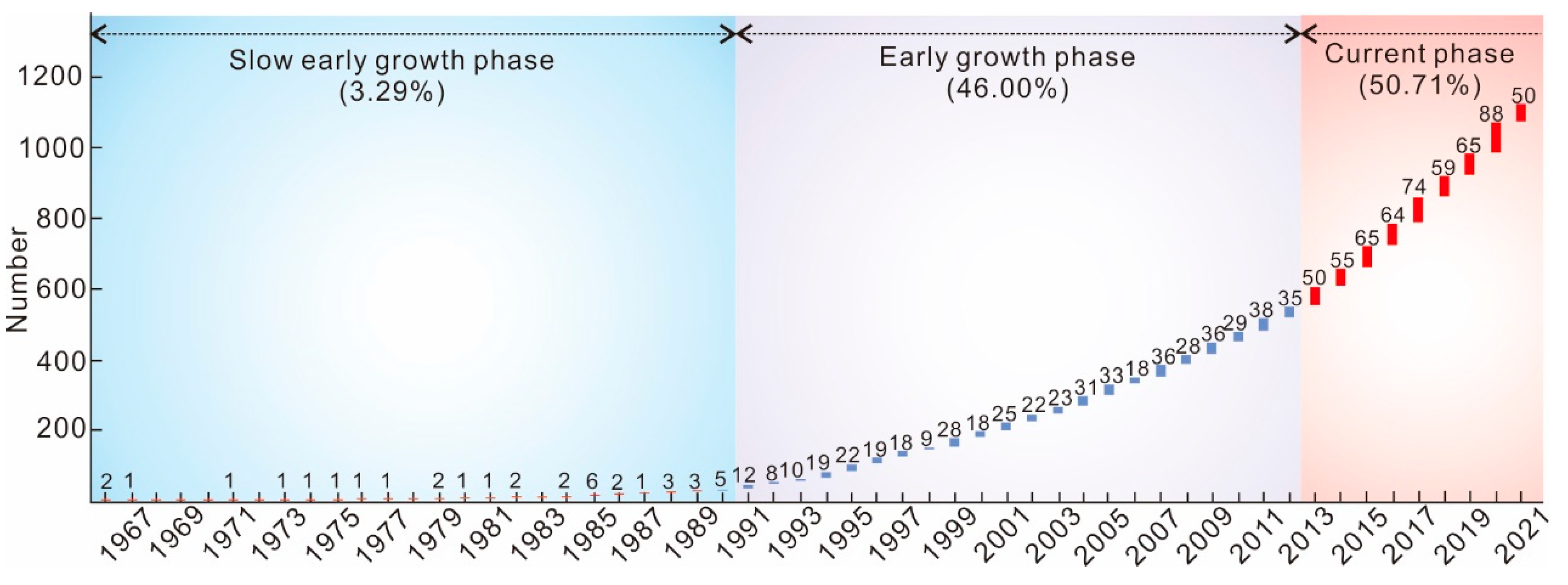
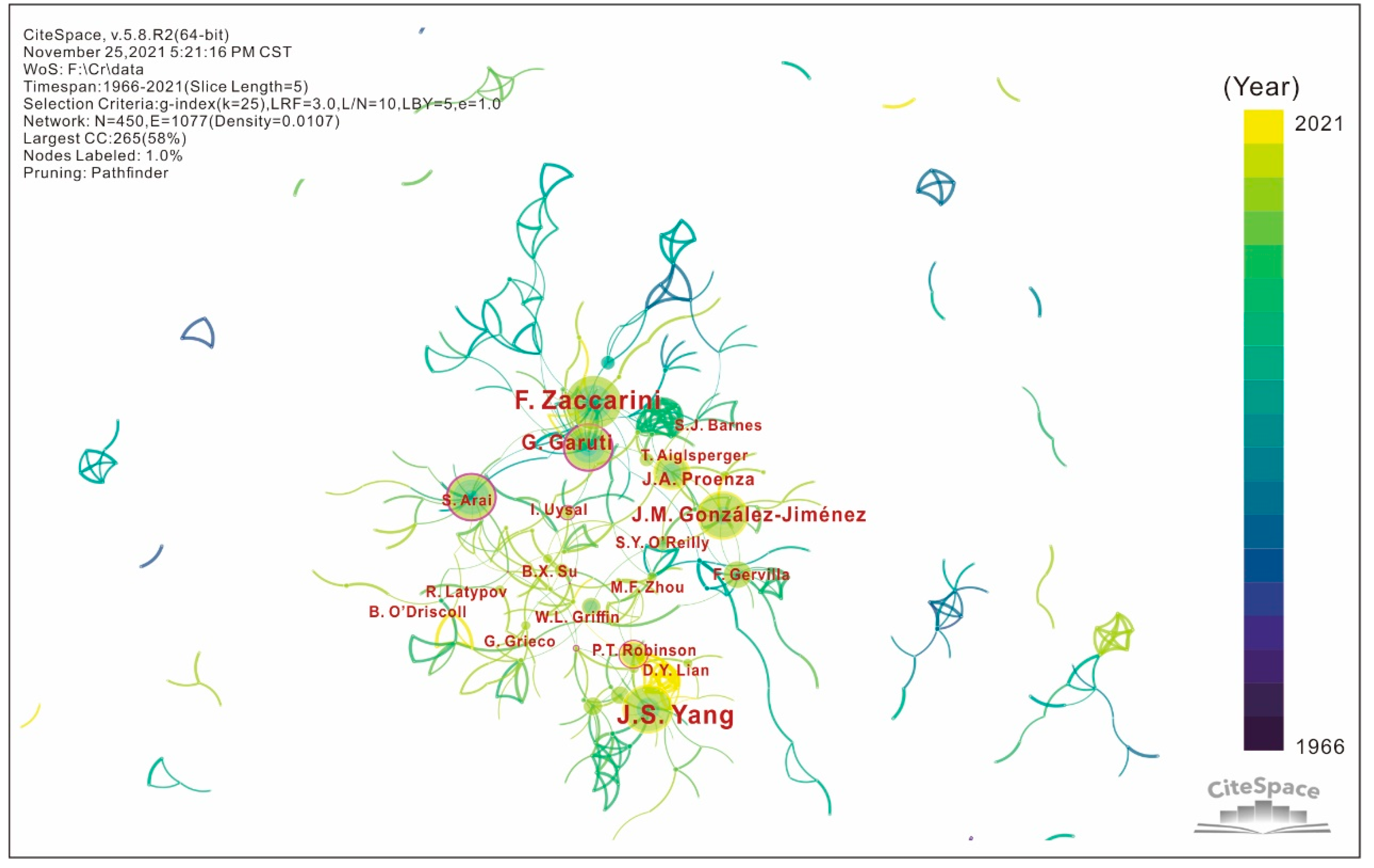
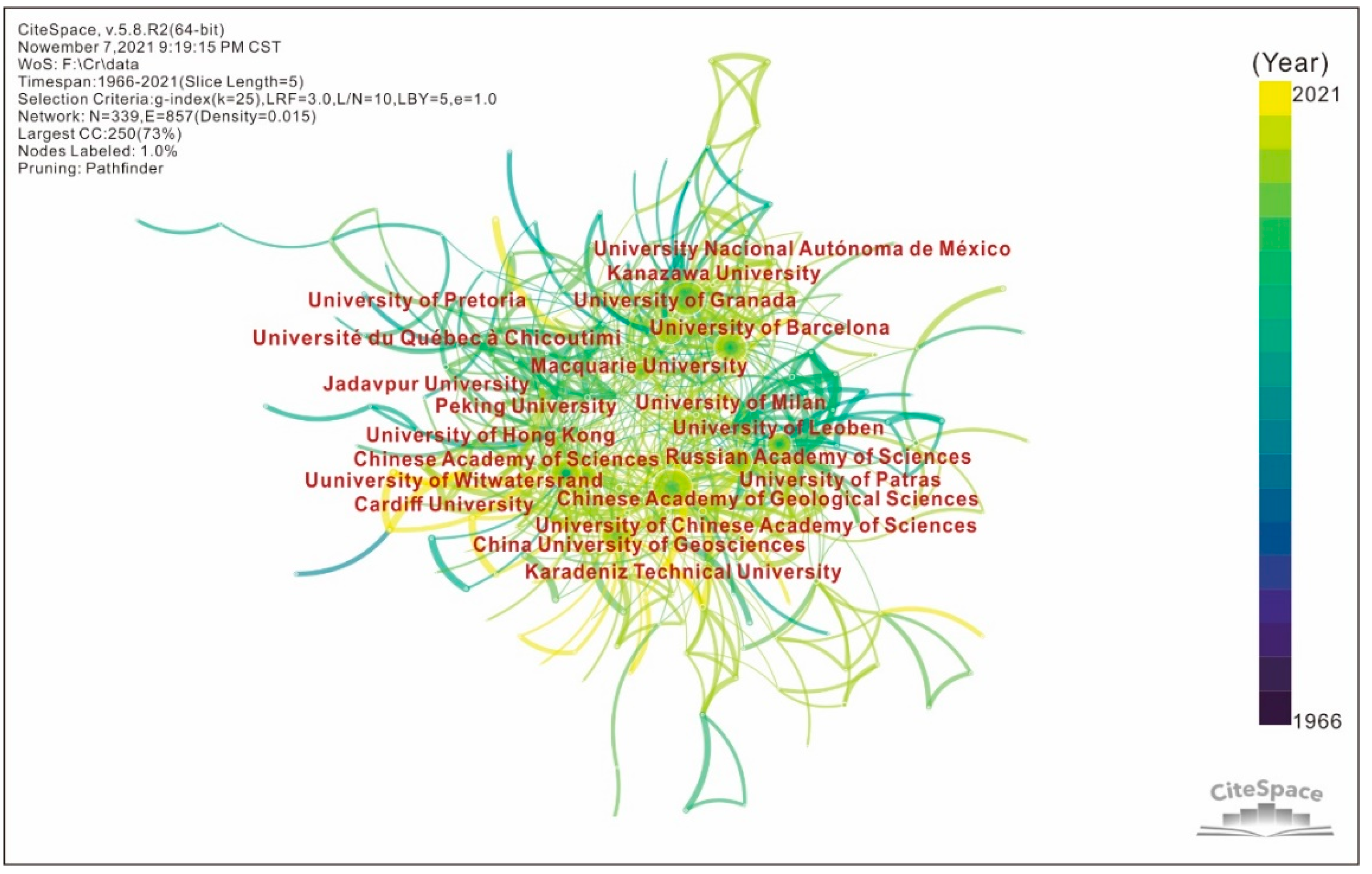
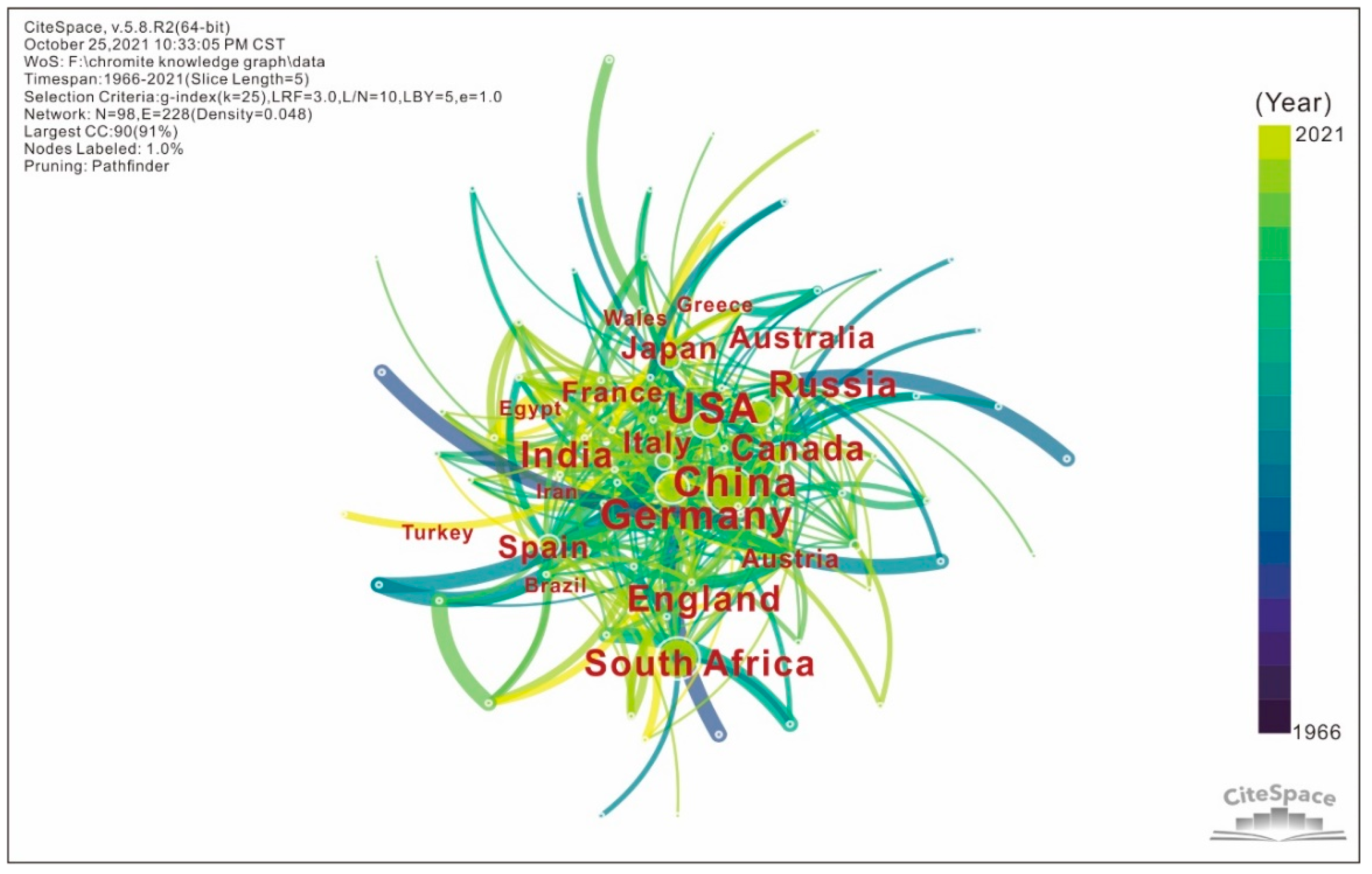

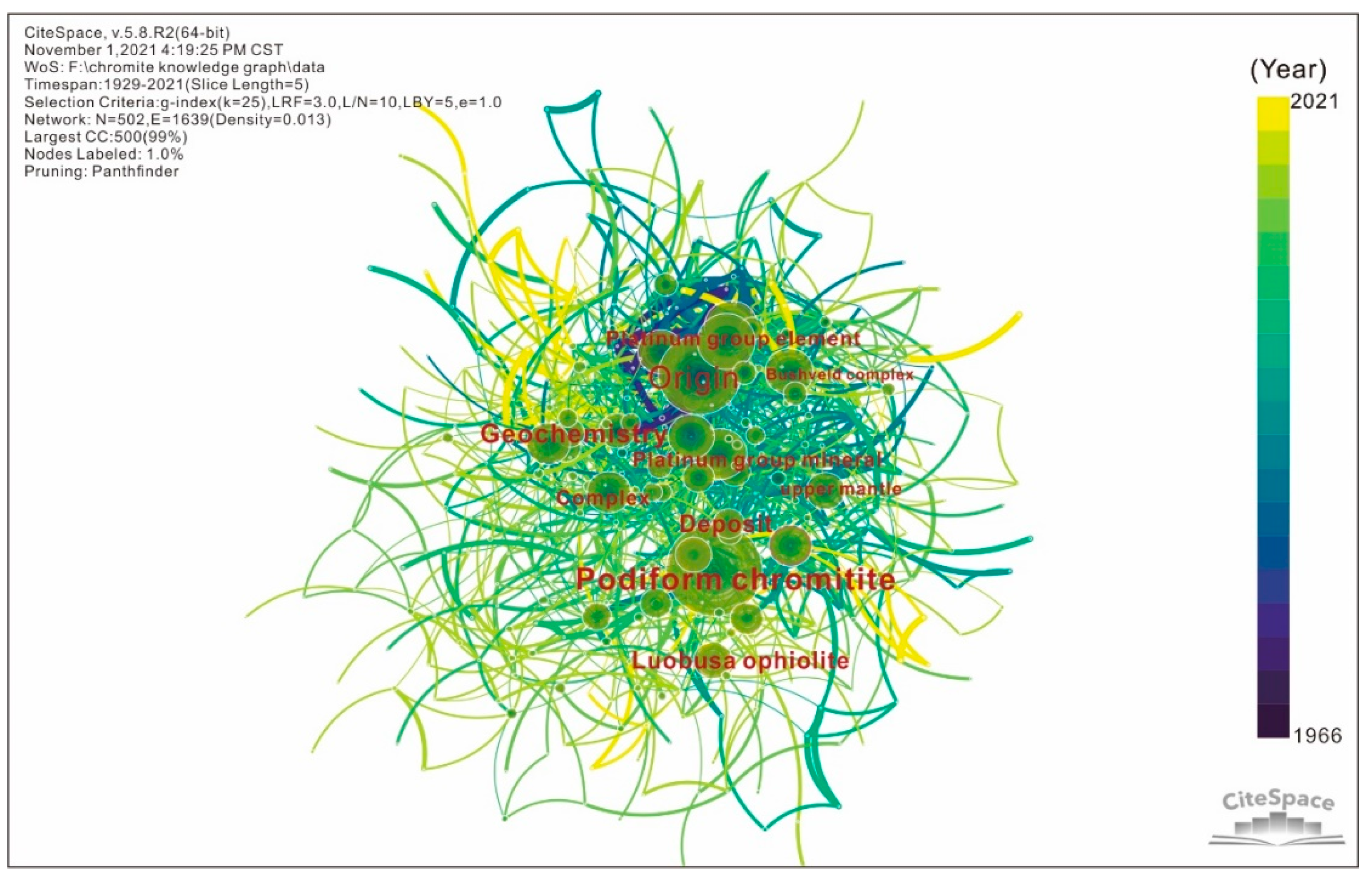
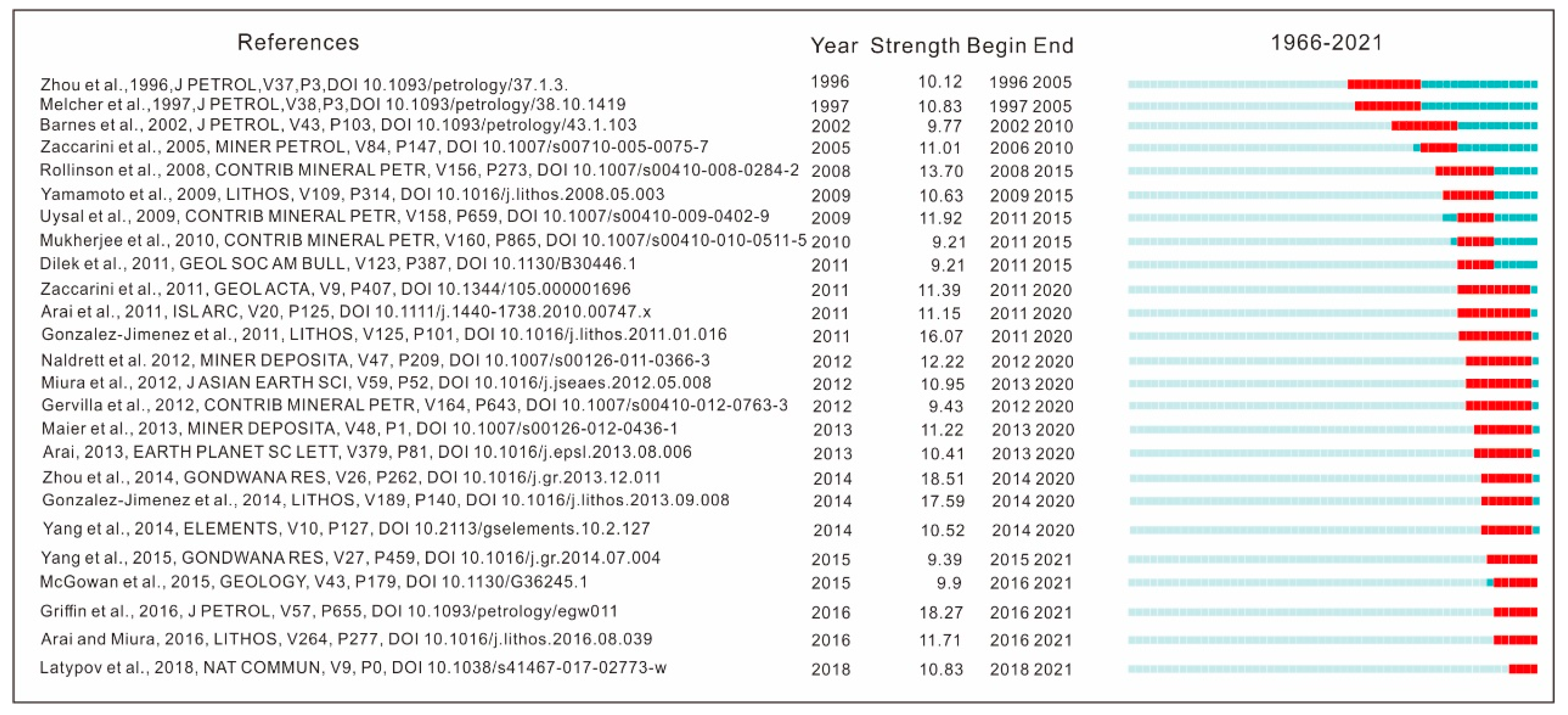

| Rank | Count | Centrality | Year | Authors |
|---|---|---|---|---|
| 1 | 61 | 0.05 | 2006 | J.S. Yang |
| 2 | 61 | 0.10 | 1997 | F. Zaccarini |
| 3 | 61 | 0.21 | 1980 | S. Arai |
| 4 | 57 | 0.26 | 1997 | G. Garuti |
| 5 | 45 | 0.07 | 2009 | J.M. González-Jiménez |
| 6 | 42 | 0.10 | 2007 | J.A. Proenza |
| 7 | 39 | 0.06 | 1999 | F. Gervilla |
| 8 | 30 | 0.10 | 2011 | P.T. Robinson |
| 9 | 25 | 0.12 | 2007 | I. Uysal |
| 10 | 24 | 0.02 | 2011 | W.L. Griffin |
| 11 | 23 | 0.00 | 2013 | F.H. Xiong |
| 12 | 23 | 0.10 | 1996 | M.F. Zhou |
| 13 | 21 | 0.06 | 2011 | S.Y. O’Reilly |
| 14 | 21 | 0.05 | 2008 | X.Z. Xu |
| 15 | 18 | 0.05 | 2014 | B.X. Su |
| 16 | 16 | 0.07 | 1996 | S.J. Barnes |
| 17 | 16 | 0.04 | 1991 | R.G. Cawthorn |
| 20 | 15 | 0.00 | 2015 | T. Aiglsperger |
| 20 | 14 | 0.03 | 2017 | D.Y. Lian |
| 20 | 14 | 0.03 | 2012 | R. Latypov |
| 20 | 14 | 0.03 | 2009 | G. Grieco |
| 20 | 14 | 0.04 | 2009 | B. O’Driscoll |
| Rank | Count | Centrality | Year | Institution |
|---|---|---|---|---|
| 1 | 70 | 0.13 | 1999 | Chinese Academy of Geological Sciences |
| 2 | 65 | 0.09 | 1997 | Russian Academy of Sciences |
| 3 | 63 | 0.15 | 1998 | Kanazawa University |
| 4 | 59 | 0.13 | 1999 | University of Barcelona |
| 5 | 59 | 0.05 | 1998 | University of Witwatersrand |
| 6 | 58 | 0.18 | 2001 | China University of Geosciences |
| 7 | 51 | 0.09 | 1999 | University of Granada |
| 8 | 46 | 0.11 | 1997 | University of Leoben |
| 9 | 45 | 0.11 | 2006 | Chinese Academy of Sciences |
| 10 | 36 | 0.04 | 2011 | Macquarie University |
| 11 | 30 | 0.11 | 1997 | Cardiff University |
| 12 | 26 | 0.07 | 2007 | Karadeniz Technical University |
| 13 | 24 | 0.06 | 2001 | University of Milan |
| 14 | 22 | 0.09 | 1998 | University of Hong Kong |
| 15 | 19 | 0.04 | 2014 | University of Chinese Academy of Sciences |
| 15 | 17 | 0.07 | 2007 | University of Patras |
| 17 | 17 | 0.02 | 2004 | University Nacional Autónoma de México |
| 17 | 17 | 0.06 | 1979 | University of Pretoria |
| 19 | 16 | 0.08 | 2003 | Peking University |
| 20 | 15 | 0.03 | 2001 | Université du Québec à Chicoutimi |
| 20 | 15 | 0.07 | 1997 | Jadavpur University |
| Rank | Count | Centrality | Year | Country |
|---|---|---|---|---|
| 1 | 179 | 0.22 | 1988 | China |
| 2 | 159 | 0.06 | 1979 | South Africa |
| 3 | 124 | 0.21 | 1973 | USA |
| 4 | 115 | 0.20 | 1984 | Canada |
| 5 | 106 | 0.12 | 1995 | Germany |
| 6 | 106 | 0.01 | 1995 | Russia |
| 7 | 100 | 0.14 | 1994 | Japan |
| 8 | 95 | 0.33 | 1990 | Australia |
| 9 | 89 | 0.21 | 1995 | Spain |
| 10 | 77 | 0.14 | 1995 | Italy |
| 11 | 72 | 0.16 | 1995 | Austria |
| 12 | 69 | 0.08 | 1997 | India |
| 13 | 67 | 0.18 | 1984 | England |
| 14 | 49 | 0.12 | 1991 | France |
| 15 | 43 | 0.10 | 2005 | Turkey |
| 16 | 40 | 0.11 | 2000 | Egypt |
| 17 | 39 | 0.04 | 1991 | Greece |
| 18 | 34 | 0.03 | 1997 | Wales |
| 19 | 32 | 0.07 | 2010 | Iran |
| 20 | 28 | 0.05 | 1995 | Brazil |
| Rank | Count | Centrality | Year | Cited Reference |
|---|---|---|---|---|
| 1 | 68 | 0.12 | 2014 | González-Jiménez et al., 2014a, LITHOS [53] |
| 2 | 60 | 0.13 | 2014 | Zhou et al., 2014, GONDWANA RESEARCH [44] |
| 3 | 59 | 0.01 | 2016 | Arai and Miura, 2016, LITHOS [54] |
| 4 | 41 | 0.03 | 2015 | Robinson et al., 2015, GONDWANA RESEARCH [45] |
| 5 | 41 | 0.06 | 2015 | Yang et al., 2015, GONDWANA RESEARCH [46] |
| 6 | 38 | 0.04 | 2013 | Maier et al., 2013, MINERALIUM DEPOSITA [57] |
| 7 | 38 | 0.08 | 2016 | Griffin et al., 2016, JOURNAL OF PETROLOGY [59] |
| 8 | 38 | 0.07 | 2011 | González-Jiménez et al., 2011, LITHOS [55] |
| 9 | 36 | 0.04 | 2012 | Naldrett et al., 2012, MINERALIUM DEPOSITA [58] |
| 10 | 35 | 0.08 | 2014 | Yang et al., 2014, ELEMENTS [43] |
| 11 | 35 | 0.00 | 2015 | McGowan et al., 2015, GEOLOGY [60] |
| 12 | 33 | 0.01 | 2015 | Rollinson et al., 2015, GONDWANA RESEARCH [47] |
| 13 | 32 | 0.03 | 2015 | Xiong et al., 2015, GONDWANA RESEARCH [48] |
| 14 | 31 | 0.03 | 2013 | Arai, 2013, EARH AND PLANETARY SCIENCE LETTERS [61] |
| 15 | 31 | 0.02 | 2016 | O’Driscoll and González-Jiménez, 2016, REVIEWS IN MINERALOGY AND GEOCHEMISTRY [62] |
| 16 | 31 | 0.00 | 2014 | González-Jiménez et al., 2014b, LITOHOS [56] |
| 17 | 29 | 0.03 | 2014 | Junge et al., 2014, ECONOMIC GEOLOGY [63] |
| 18 | 29 | 0.01 | 2012 | Miura et al. 2012, JOURNAL ASIAN EARTH SCI [64] |
| 19 | 27 | 0.00 | 2015 | Xu et al., 2015, GONDWANA RESEARCH [49] |
| 20 | 27 | 0.03 | 2011 | Zaccarini et al., 2011, GEOLOGICA ACTA [65] |
| 20 | 27 | 0.07 | 2015 | González-Jiménez et al., 2015, GONDWANA RESEARCH [50] |
Publisher’s Note: MDPI stays neutral with regard to jurisdictional claims in published maps and institutional affiliations. |
© 2022 by the authors. Licensee MDPI, Basel, Switzerland. This article is an open access article distributed under the terms and conditions of the Creative Commons Attribution (CC BY) license (https://creativecommons.org/licenses/by/4.0/).
Share and Cite
Cai, P.; Yang, J.; Lian, D.; Wu, W.; Yang, Y.; Rui, H. Knowledge Structure and Frontier Evolution of Research on Chromitite: A Scientometric Review. Minerals 2022, 12, 1211. https://doi.org/10.3390/min12101211
Cai P, Yang J, Lian D, Wu W, Yang Y, Rui H. Knowledge Structure and Frontier Evolution of Research on Chromitite: A Scientometric Review. Minerals. 2022; 12(10):1211. https://doi.org/10.3390/min12101211
Chicago/Turabian StyleCai, Pengjie, Jingsui Yang, Dongyang Lian, Weiwei Wu, Yu Yang, and Huichao Rui. 2022. "Knowledge Structure and Frontier Evolution of Research on Chromitite: A Scientometric Review" Minerals 12, no. 10: 1211. https://doi.org/10.3390/min12101211
APA StyleCai, P., Yang, J., Lian, D., Wu, W., Yang, Y., & Rui, H. (2022). Knowledge Structure and Frontier Evolution of Research on Chromitite: A Scientometric Review. Minerals, 12(10), 1211. https://doi.org/10.3390/min12101211








